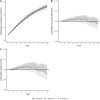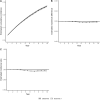Restricting Periodontal Treatment Frequency: Impact on Tooth Loss in Danish Adults
- PMID: 39715711
- PMCID: PMC11892545
- DOI: 10.1111/cdoe.13022
Restricting Periodontal Treatment Frequency: Impact on Tooth Loss in Danish Adults
Abstract
Objective: The study aimed to estimate the effect of a periodontal treatment policy that would restrict the receipt of periodontal therapy to no more than once every second year, on the 10-year risk of tooth extraction among Danish adults.
Methods: Data from linked nationwide Danish registers consisted of a random sample of 20 000 50-year-olds who were followed from the beginning of 1990 to the end of 2021. The longitudinal modified treatment policies' causal inference framework was used. In each of two slightly different counterfactual scenarios, the receipt of supragingival or subgingival periodontal therapy was restricted to no more than once every second year. The cumulative incidence of tooth extraction from 2012 to 2021 was compared between the counterfactual scenarios and the observed periodontal visiting pattern, while informative censoring, and time-varying and time-invariant confounding were accounted for using the social, economic and dental service utilisation history.
Results: During the 10-year follow-up period, 5021 (25.1%) individuals received at least one tooth extraction. In the two counterfactual scenarios, the number of years receiving supragingival or subgingival periodontal therapy was 30%-50% lower than in the observed data. The 10-year cumulative incidence of tooth loss was practically the same in the two counterfactual scenarios as under the observed periodontal visiting patterns.
Conclusion: The findings indicate that a considerable decrease in the number and frequency of periodontal care visits would not have significant impact on the incidence of tooth loss in Denmark.
Keywords: Dental services research; Epidemiology; Periodontitis; Public health policy; Statistics.
© 2024 The Author(s). Community Dentistry and Oral Epidemiology published by John Wiley & Sons Ltd.
Conflict of interest statement
The authors declare no conflicts of interest.
Figures





Similar articles
-
Periodontal conditions in 35-44 and 65-74-year-old adults in Denmark.Acta Odontol Scand. 2006 Apr;64(2):65-73. doi: 10.1080/00016350500377859. Acta Odontol Scand. 2006. PMID: 16546847
-
Initial extractions and tooth loss during supportive care in a periodontal population seeking comprehensive care.J Clin Periodontol. 2000 Nov;27(11):824-31. doi: 10.1034/j.1600-051x.2000.027011824.x. J Clin Periodontol. 2000. PMID: 11073325
-
Periodontal reasons for tooth loss in an Asian population.J Clin Periodontol. 1996 Apr;23(4):307-9. doi: 10.1111/j.1600-051x.1996.tb00550.x. J Clin Periodontol. 1996. PMID: 8739160
-
Periodontal diseases and tooth loss.Periodontol 2000. 1993 Jun;2:117-27. doi: 10.1111/j.1600-0757.1993.tb00224.x. Periodontol 2000. 1993. PMID: 9673185 Review. No abstract available.
-
Periodontal disease and tooth loss.Int Dent J. 1998 Jun;48(3 Suppl 1):233-8. doi: 10.1111/j.1875-595x.1998.tb00711.x. Int Dent J. 1998. PMID: 9779103 Review.
Cited by
-
Practice-Level Variation in the Provision of Subsidised Dental Services to Adult Danes in 2019: A Register-Based Study.Community Dent Oral Epidemiol. 2025 Aug;53(4):452-464. doi: 10.1111/cdoe.13048. Epub 2025 Jun 3. Community Dent Oral Epidemiol. 2025. PMID: 40462288 Free PMC article.
References
-
- Chapple I. L., Van der Weijden F., Doerfer C., et al., “Primary Prevention of Periodontitis: Managing Gingivitis,” Journal of Clinical Periodontology 42, no. Suppl 16 (2015): S71–S76. - PubMed
-
- West N., Chapple I., Claydon N., et al., “BSP Implementation of European S3—Level Evidence‐Based Treatment Guidelines for Stage I–III Periodontitis in UK Clinical Practice,” Journal of Dentistry 106 (2021): 103562. - PubMed
MeSH terms
Grants and funding
LinkOut - more resources
Full Text Sources

